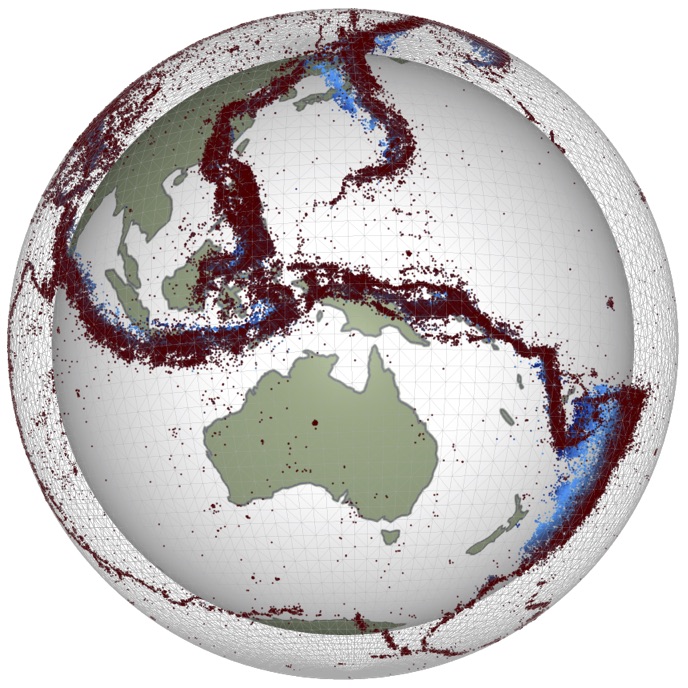Projection-based function evaluation#
Here we Use SNES solvers to project sympy / mesh variable functions and derivatives to nodes. Pointwise / symbolic functions cannot always be evaluated using uw.function.evaluate because they contain a mix of mesh variables, derivatives and symbols which may not be defined everywhere.
Our solution is to use a projection of the function to a continuous mesh variable with the SNES machinery performing all of the background operations to determine the values and the optimal fitting.
This approach also allows us to include boundary conditions, smoothing, and constraint terms (e.g. remove a null space) in cases (like piecewise continuous swarm variables) where this is difficult in the original form.
We’ll demonstrate this using a swarm variable (scalar / vector), but the same approach is useful for gradient recovery.
# to fix trame issue
import nest_asyncio
nest_asyncio.apply()
import underworld3 as uw
import numpy as np
import sympy
from underworld3.meshing import UnstructuredSimplexBox
meshbox = UnstructuredSimplexBox(minCoords=(0.0, 0.0),
maxCoords=(1.0, 1.0),
cellSize=1.0 / 32.0,)
# import meshio
# mesh2 = meshio.read(filename="../Examples-StokesFlow/tmp_ball.vtk")
# meshio.write(filename="tmp_ball.msh", mesh=mesh2)
import sympy
# Some useful coordinate stuff
x, y = meshbox.X
s_soln = uw.discretisation.MeshVariable("T", meshbox, 1, degree=2)
v_soln = uw.discretisation.MeshVariable("U", meshbox, meshbox.dim, degree=2)
s_fn = sympy.cos(5.0 * sympy.pi * x) * sympy.cos(5.0 * sympy.pi * y)
v_fn = sympy.Matrix([sympy.cos(5.0 * sympy.pi * y) ** 2, -sympy.sin(5.0 * sympy.pi * x) ** 2]) # divergence free
meshbox.vector.divergence(v_fn)
swarm = uw.swarm.Swarm(mesh=meshbox)
s_values = uw.swarm.SwarmVariable("Ss", swarm, 1, proxy_degree=3)
v_values = uw.swarm.SwarmVariable("Vs", swarm, meshbox.dim, proxy_degree=3)
# iv_values = uw.swarm.SwarmVariable("Vi", swarm, meshbox.dim, proxy_degree=3)
swarm.populate(fill_param=3)
scalar_projection = uw.systems.Projection(meshbox, s_soln)
scalar_projection.uw_function = s_values.sym
scalar_projection.smoothing = 1.0e-6
vector_projection = uw.systems.Vector_Projection(meshbox, v_soln)
vector_projection.uw_function = v_values.sym
vector_projection.smoothing = 1.0e-6 # see how well it works !
vector_projection.penalty = 1.0e-6
# Velocity boundary conditions (compare left / right walls in the soln !)
vector_projection.add_dirichlet_bc(v_fn, "Left", (0, 1))
vector_projection.add_dirichlet_bc(v_fn, "Right", (0, 1))
vector_projection.add_dirichlet_bc(v_fn, "Top", (0, 1))
vector_projection.add_dirichlet_bc(v_fn, "Bottom", (0, 1))
with swarm.access(s_values, v_values):
s_values.data[:, 0] = uw.function.evaluate(s_fn, swarm.data, meshbox.N)
v_values.data[:, 0] = uw.function.evaluate(v_fn[0], swarm.data, meshbox.N)
v_values.data[:, 1] = uw.function.evaluate(v_fn[1], swarm.data, meshbox.N)
scalar_projection.solve()
vector_projection.solve()
scalar_projection.uw_function = meshbox.vector.divergence(v_soln.sym)
scalar_projection.solve()
s_soln.stats()
# check the projection
if uw.mpi.size == 1:
import pyvista as pv
import underworld3.visualisation as vis
pvmesh = vis.mesh_to_pv_mesh(meshbox)
pvmesh.point_data["S"] = vis.scalar_fn_to_pv_points(pvmesh, s_soln.sym)
velocity_points = vis.meshVariable_to_pv_cloud(v_soln)
velocity_points.point_data["V"] = vis.vector_fn_to_pv_points(velocity_points, v_soln.sym)
pl = pv.Plotter(window_size=(1000, 750))
# pl.add_mesh(pvmesh,'Black', 'wireframe')
pl.add_mesh(
pvmesh, cmap="coolwarm", edge_color="Black", show_edges=True, scalars="S", use_transparency=False, opacity=0.5
)
pl.add_arrows(velocity_points.points, velocity_points.point_data["V"], mag=1.0e-1, opacity=0.5)
# pl.add_arrows(arrow_loc2, arrow_length2, mag=1.0e-1)
# pl.add_points(pdata)
pl.show(cpos="xy")

